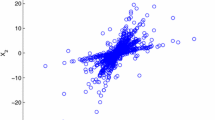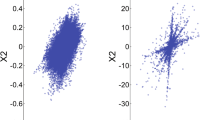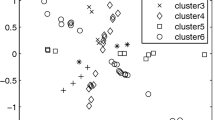Abstract
Considering the time-delayed mixing model of the underdetermined blind source separation problem, we propose a novel mixing matrix estimation algorithm in this paper. First, we introduce the short-time Fourier transform (STFT) to transform the mixed signals from the time domain to the time–frequency domain. Second, a neoteric transformation matrix is addressed to construct the linear clustering property of STFT coefficients. Then, a preeminent detection algorithm is raised to identify the single source points. After eliminating the low-energy points and outliers in the time–frequency domain, a potential function of clustering approach is put forward to cluster the single source points and obtain the clustering centers. Finally, the mixing matrix can be estimated through the derivation and calculation. The experimental results validate that the proposed algorithm not only accurately estimates the mixing matrix for the time-delayed mixing model of the underdetermined blind source separation problem but also has certain universality for different array structures. Therefore, both the effectiveness and superiority of the proposed algorithm have been verified.






Similar content being viewed by others
References
T. Adali, Y. Levin-Schwartz, V.D. Calhoun, Multimodal data fusion using source separation: application to medical imaging. Proc. IEEE 103(9), 1494–1506 (2015)
T. Dong, Y. Lei, J. Yang, An algorithm for underdetermined mixing matrix estimation. Neurocomputing 104, 26–34 (2013)
J. Du, Y. Tu, L.R. Dai, A regression approach to single-channel speech separation via high-resolution deep neural networks. IEEE/ACM Trans. Audio Speech Lang. Process. 24(8), 1424–1437 (2016)
R. Gribonval, S. Lesage, A survey of sparse component analysis for blind source separation: principles, perspectives, and new challenges, in ESANN’2006 Proceedings—European Symposium on Artificial Neural Networks ,Bruges (Belgium), pp. 26–28 (2006)
Y.J. Gu, N.A. Goodman, Information-theoretic compressive sensing kernel optimization and Bayesian Cramer-Rao bound for time delay estimation. IEEE Trans. Signal Process. 65(17), 4525–4537 (2017)
A. Hyvarinen, Fast and robust fixed-point algorithms for independent component analysis. IEEE Trans. Neural Netw. 10(3), 626–634 (1999)
Y. Jiang, J.P. Wu, C.Q. Zong, An effective diagnosis method for single and multiple defects detection in gearbox based on nonlinear feature selection and kernel-based extreme learning machine. J. Vibroeng. 16(1), 499–512 (2014)
S. Kim, C.D. Yoo, Underdetermined blind source separation based on subspace representation. IEEE Trans. Signal Process. 57(7), 2604–2614 (2009)
H. Li, Y.H. Shen, J.G. Wang, Estimation of the complex-valued mixing matrix by single-source-points detection with less sensors than sources. Trans. Emerg. Telecommun. Technol. 23(2), 137–147 (2012)
Y.B. Li, W. Nie, F. Ye, A mixing matrix estimation algorithm for underdetermined blind source separation. Circuits Systems Signal Process. 35(9), 3367–3379 (2016)
K. Mohanaprasad, P. Arulmozhivarman, Wavelet-based ICA using maximum likelihood estimation and information-theoretic measure for acoustic echo cancellation during double talk situation. Circuits Systems Signal Process. 34(12), 3915–3931 (2015)
A. Mustafi, S.K. Ghorai, A novel blind source separation technique using fractional Fourier transform for denoising medical images. Optik 124(3), 265–271 (2013)
G.R. Naik, D.K. Kumar, An overview of independent component analysis and its applications. Informatica 35(1), 63–81 (2011)
F.M. Naini, G.H. Mohimani, M. Babaie-Zadeh, Estimating the mixing matrix in sparse component analysis (SCA) based on partial k-dimensional subspace clustering. Neurocomputing 71(10), 2330–2343 (2008)
M. Puigt, Y. Deville, Time-frequency ratio-based blind separation methods for attenuated and time-delayed sources. Mech. Syst. Signal Process. 19(6), 1348–1379 (2005)
S. Qin, J. Guo, C. Zhu, Sparse component analysis using time-frequency representations for operational modal analysis. Sensors 15(3), 6497–519 (2015)
V.G. Reju, S.N. Koh, I.Y. Soon, An algorithm for mixing matrix estimation in instantaneous blind source separation. Signal Process. 89(9), 1762–1773 (2009)
Z.G. Shi, C.W. Zhou, Y.J. Gu, Source estimation using coprime array: a sparse reconstruction perspective. IEEE Sens. J. 17(3), 755–765 (2017)
J. Sun, Y. Li, J. Wen, Novel mixing matrix estimation approach in underdetermined blind source separation. Neurocomputing 173(P3), 623–632 (2016)
R. Takeda, K. Nakadai, T. Takahashi, Efficient blind dereverberation and echo cancellation based on independent component analysis for actual acoustic signals. Neural Comput. 24(1), 234–272 (2012)
J.J. Thiagarajan, K. Natesan Ramamurthy, A. Spanias, Mixing matrix estimation using discriminative clustering for blind source separation. Digital Signal Process. 23(1), 9–18 (2013)
O. Yilmaz, S. Rickard, Blind separation of speech mixtures via time-frequency masking. IEEE Trans. Signal Process. 52(7), 1830–1847 (2004)
G. Yu, Fault feature extraction using independent component analysis with reference and its application on fault diagnosis of rotating machinery. Neural Comput. Appl. 26(1), 187–198 (2015)
X.C. Yu, J.D. Xu, H. Dan, A new blind image source separation algorithm based on feedback sparse component analysis. Signal Process. 93(1), 288–296 (2013)
H. Zayyani, M. Babaie-Zadeh, Approximated Cramer-Rao bound for estimating the mixing matrix in the two-sensor noisy sparse component analysis (SCA). Digital Signal Process. 23(3), 771–779 (2013)
H. Zayyani, M. Babaie-Zadeh, F. Haddadi, On the Cramer-Rao bound for estimating the mixing matrix in noisy sparse component analysis. IEEE Signal Process. Lett. 15, 609–612 (2008)
H. Zayyani, M. Babaie-Zadeh, C. Jutten, An iterative Bayesian algorithm for sparse component analysis in presence of noise. IEEE Trans. Signal Process. 57(11), 4378–4390 (2009)
L. Zhang, J. Yang, Z. Guo, Underdetermined blind source separation from time-delayed mixtures based on prior information exploitation. J. Electr. Eng. Technol. 10(5), 2179–2188 (2015)
Acknowledgements
The paper is funded by the National Natural Science Foundation of China (No. 61701134), the Natural Science Foundation of Heilongjiang Province, China (No. F2017004), and the National Key Research and Development Program of China (No. 2016YFF0102806). Moreover, this work is supported by the Fundamental Research Funds for the Central Universities of China (Nos. HEUCFM180801, HEUCFM180802), and the Ph.D. Student Research and Innovation Fund of the Fundamental Research Funds for the Central Universities of China (No. HEUGIP201708).
Author information
Authors and Affiliations
Corresponding author
Rights and permissions
About this article
Cite this article
Ye, F., Chen, J., Gao, L. et al. A Mixing Matrix Estimation Algorithm for the Time-Delayed Mixing Model of the Underdetermined Blind Source Separation Problem. Circuits Syst Signal Process 38, 1889–1906 (2019). https://doi.org/10.1007/s00034-018-0930-5
Received:
Revised:
Accepted:
Published:
Issue Date:
DOI: https://doi.org/10.1007/s00034-018-0930-5




